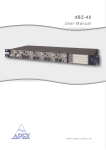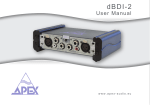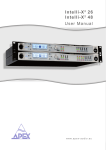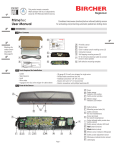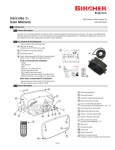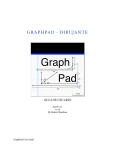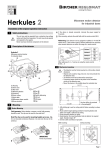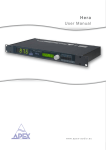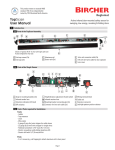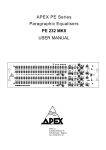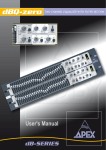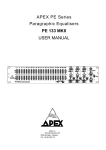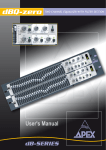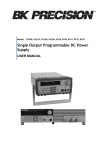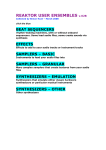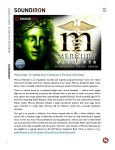Download Apex dBC-8 User Manual
Transcript
APEX NV Schoebroekstraat 62 3583 Beringen (Paal) BELGIUM Tel: + 32 (0)11 28 61 91 Fax: + 32 (0)11 25 56 38 email: [email protected] website: www.apex-audio.be Environmental precaution EU Directive 2002/96/EC Remark: This notice applies only to countries within the European Union (EU) and Norway Electrical and electronic equipment may contain hazardous substances for humans and their environment. The “crossed out wheelie bin” symbol present on the device and represented above is there to remind one of the obligation of selective collection of waste. This label is applied to various products to indicate that the product is not to be thrown away as unsorted municipal waste. At the end of life, dispose of this product by returning it to the point of sale or to your local municipal collection point for recycling of electric and electronic devices. Customer participation is important to minimize the potential affects on the environment and human health that can result from hazardous substances that may be contained in this product. Please, dispose of this product and its packaging in accordance with local and national disposal regulations including those governing the recovery and recycling of waste electrical and electronic equipment. Contact your local waste administration, waste collection company or dealer. INTRODUCTION Thank you for buying the Apex dBC-8. The Apex dBC-8 is part of the Apex dB-series of professional audio equipment offering unprecedented quality for money. The dBC-8 offers 8 channels of compression in an ultra compact package but without compromising quality. If you are used to working with compressors you will immediately find your way about the dBC-8. However if you would like to make the best use of the dBC-8 or would like to know more about compressors in general, we invite you to read this manual. UNPACKING AND SAFETY Follow all warnings and instructions. Install in accordance with the manufacturer’s instructions. Proper power cord This product is intended to operate from a regular 220V AC outlet Use only the power cord and connector specified for the product and your operating locale. Use only a cord that is in good condition. Protect the power cord from being walked on or pinched, particularly at the plug, convenience receptacle, and the point where the cord exits from the apparatus. Grounding Operating location The chassis of this product is grounded through the power cord. To avoid electric shock, plug the power cord into a properly wired receptacle before making any connections to the product. A protective ground connection, by way of the grounding conductor in the power cord, is essential for safe operation. Do not defeat the safety purpose of the grounding plug. The grounding plug has two blades and a third grounding prong. The third prong is provided for your safety. When the provided plug does not fit your outlet, consult an electrician for replacement of the obsolete outlet. Do not operate this equipment under any of the following conditions: explosive atmospheres, in wet locations, in inclement weather, improper or unknown AC mains voltage, or if improperly fused. Do not install near any heat source such as radiators, heat registers, stoves, or other apparatus (including amplifiers) that produce heat. Unplug this apparatus during lightning storms or when unused for long periods of time. Power Source Stay out of the box To avoid personal injury (or worse), do not remove the product covers or panels. Do not operate the product without the covers and panels properly installed. Only use accessories specified by the manufacturer. Clean only with a damp cloth. Danger from loss of ground If the protective ground connection is lost, all accessible conductive parts, including knobs and controls that may appear to be insulated, can render an electric shock. User-serviceable parts There are no user serviceable parts inside the dBC-8. In case of failure, refer all servicing to the factory. Servicing is required when the dBC-8 has been damaged in any way, such as when a power supply cord or plug is damaged, liquid has been spilled or objects have fallen into the apparatus, the apparatus has been exposed to rain or moisture, does not operate normally, or has been dropped. Equipment markings The lightning flash with arrowhead symbol within an equilateral triangle is intended to alert the user of the presence of uninsulated “dangerous voltage” within the product’s enclosure that may be of sufficient magnitude to constitute a risk of electric shock to persons. The exclamation point within an equilateral triangle is intended to alert the user of the presence of important operating and maintenance (servicing) instructions in the literature accompanying the product (i.e., this user guide). CAUTION To prevent electric shock, do not use the polarized plug supplied with the unit with any extension cord, receptacle, or other outlet unless the prongs can be fully inserted. WARNING: TO REDUCE THE RISK OF FIRE OR ELECTRIC SHOCK DO NOT EXPOSE THIS EQUIPMENT TO RAIN OR MOISTURE ABBREVIATIONS AND DEFINITIONS OF TERMS dB: the decibel is not a unit but expresses a ratio. The range of numbers associated with sound is related to the sensitivity of the human ear which is quiet enormous. The threshold of hearing occurs at approximately 20 µPa (micro Pascal) while the threshold of pain is situated above 100 Pa. This means that the range is quiet enormous. We perceive frequencies from around 20Hz to 20kHz and we experience the interval between 400Hz and 800Hz (range of 400Hz) as equal to the interval between 4kHz and 8kHz (range of 4000Hz). This all led to the use of the logarithmic scale of the decibel. dBu: when using decibels we are thus expressing ratio’s. And when expressing ratio’s we have to use a reference value. In the case of ‘dBu’, this reference is 0,775 Volt. Do not confound with dBU or dBV where the reference is 1 Volt. RMS: the rms value is the square root of the mean of the sum of the squares of the root mean square. Electrical power is proportional to the square of the RMS voltage, and acoustic power is proportional to the square of the RMS sound pressure. In more common words this is the mean value compared to the peak (or sometimes called program) value. Attack Time: The time it takes for a processor to alter between two states. For example in the case of a compressor: the time it takes the compressor to change between a linear transfer function and the compression function. In simple words: how much time it will take the compressor to start compressing when the level exceeds the threshold. On the dBC-8 this value can be set by the user between 1 msecond and 100 mseconds. Release Time: The time it takes the processor to reverse its state. For example in the case of a compressor: the time it will take the compressor to go back to a linear transfer function when the level has dropped below the threshold. On the dBC-8 this value can be set by the user between 30 mseconds and 3 seconds. Ratio: Indicates the amount of compression. PRODUCT HIGHLIGHTS The dBC-8 offers 8 individual compressors in an extremely compact package. The user controls are extremely straightforward and intuitive. Connections are balanced on TRS-Jacks. The dBC-8 offers professional sound quality with user friendly controls in a compact housing. APPLICATIONS Applications include live-sound PA: compression on individual instruments to control the dynamics of the audio signal, to avoid unexpected peaks or drops in level and to maintain full control over the balance between the different instruments and vocals. Recording: fitting the dynamics of the acoustic signal to the specifications of the recording media. Compression can also be used to alter the characteristics of individual sounds. ONLINE REGISTRATION FRONT AND REAR PANEL DESCRIPTION All 8 channels being equal, only one channel is described. FRONT PANEL 3 4 7 8 1 2 5 6 1: THRESHOLD: variable between -30 dBu and +10 dBu. When the input level reaches the level set by this control the compressor will start to act and alter the dynamics of the input channel. When the sound level and the input stays under the threshold, the compressor is not active and there will be no change to the dynamics of the input channel. 2: RATIO: indicates the amount of compression that will be applied to the input signal when this signal exceeds the threshold level. Variable between 1:1 (no compression, linear transfer function) and ∞:1 or infinity:1 (limiting: the input level may continue to rise, the output level will stay quasi fixed). 3: ATTACK: variable between 1mseconds and 0,1 seconds. This parameters sets the time it will take the compressor to reach full compression (as set by the ratio control) when the input level exceeds the threshold level. 4: RELEASE: the time it will take to return to a linear transfer function when the input level has dropped under the threshold level again. In other words: how long it will take the dBC-8 to stop compressing when the signal is under the threshold. 5: BYPASS: activating this switch will connect the input to the output of that channel, thus bypassing the compressor functions. The green LED indicates that the bypass functions is active, so the compressor is not in the signal path. Sound passes unaltered. 6: LINK: activating activating this switch will link the two channels on either side of the switch. Only the controls of the left channels will influence the behavior of the compressor. Use this function when working with stereo signals to avoid influencing the stereo sound image by unmatched control settings. The red LED will indicate that linking is active. 7: INPUT METER: these these four green LED’s will give you an indication of the level present on the input. 8: COMPRESSION METER: these four red LED’s will give you an indication of the amount of compression that is applied. REAR PANEL 1 2 3 4 5 1. POWER INLET: please connect the supplied power chord to this inlet. The power supply of the dBG-8 is auto-sensing and accepts between 100V and 230V (50-60Hz). Do never connect a broken or damaged power chord or when not sure what the voltage is. 2. POWER SWITCH: turns the unit on or off. 3. FUSE: do not replace with another value other that that mentioned! 4. CH IN: channel input, use standard TRS Jack for balanced connection 5. CH OUT: channel output, use standard TRS Jack for balanced connection CONNECTING Cable connections Most of the time a compressor is connected to the insert point of a mixing desk. However, nothing prevents you to insert the compressor elsewhere in the signal path, but do remember that the compressor does expect a line level input. Mic level signals may be used but you will find that they have too low a level to be controlled precisely. The dBC-8 is a professional piece of equipment and has balanced in- and outputs where Tip is +, Ring is – and Sleeve is Ground. When your console has an unbalanced insert point, mostly in the form of a single TRS chassis connector, please verify which part of the TRS jack carries the send and return signal. Most consoles have the send signal on the TIP of the connector and the return signal on the RING of the connector. The ground of both signals is shared on the SLEEVE of the connector. Connect the Send signal to the Input of the dBC-8 and the Output of the dBC-8 to the Return signal. TIP: when by accident you exchange the in- and out-put connections on the dBC-8 the gate will not function. Sound will not pass through the dBC-8 UNLESS you hit the bypass function! Bypass will connect the input to the output and sound will pass, even when you reverse input and output. This may lead you to think that one or more channels of the dBC-8 are malfunctioning. So please always verify your connections. MIXING CONSOLE UNBALANCED CONNECTION INSERT Connection could vary from console manufacturer ! send return 10 When you have a balanced insert point or are inserting the gate in a balanced line, connect the output or send signal of the console or line to the input of the dBC-8, and connect the output of the gate to the Return or input connection of the console or line. BALANCED CONNECTION SEND > INPUT OUTPUT > RETURN MIXING CONSOLE SEND INSERT RETURN + GND + GND + GND Grounds Connecting a number of equipment via inputs and outputs, especially when going from one piece of equipment to another and returning, can cause hum, generated by ground loops. Connections to the safety “earth” via the power chord can participate to this hum problem. DO NEVER CUT THE EARTHING of equipment which is meant to be earthed. In case of persisting hum problems you can try to lift the ground on the dBC-8 respective input(s). This is done via a jumper on the circuit board. Removing this jumper will disconnect the electrical circuit ground from the chassis of the dBC-8. This requires opening up the equipment and should only be done by qualified technicians. 11 WHAT IS THE USE OF A COMPRESSOR AND HOW TO USE IT In this chapter we will briefly try to explain why the compressor was invented and how it is used. But whatever we are telling you, please feel free to experiment and make creative use of the dBC-8 (just remember that all tricks explained in this manual are normally done by trained professionals). Let us first define the term ‘dynamic range’. Every instrument, vocal, audio equipment has its dynamic range. It is the difference between the loudest level it can produce/accept on one side and the lowest level it can produce or the noise it will generate itself on the other side. Sometimes the dynamic range of the acoustic source does not fit in the dynamic range of a certain media or piece of equipment. Let’s give an example: a symphonic orchestra has a very extended dynamic range. Between playing at its most silent (for example only the solo first violin in a very silent passage) and its most loud (every instrument together and let’s throw in that church organ and some choir’s) there can be a range of 108dB!!!! The human ear (when we are young and still pretty) can handle a dynamic range of 120dB. But let us consider some other values. A standard living room in a semi-urban area will have a background noise of around 32dB. To fit the dynamic range of the orchestra into you living room, the quietest passage should be above 32dB which means the loudest will be around 140dB. Goodbye speakers, goodbye ears….. Or let us consider the dynamic range of an analogue cassette: 55dB, analogue tape: 70dB, the acclaimed Compact Disc: 96dB! It is clear that in a number of occasions we cannot fit the dynamic range of the source in the media or equipment. So mankind developed equipment to reduce the dynamic range. This compression is not only used for pure musical applications, analogue telephone lines for example have a very limited dynamic range, but there were (is) a time when those were used to transfer audio programs by broadcasters! So the first use of a compressor is to reduce the dynamics of the source material to fit a certain media or range of equipment. There is another reason to use a compressor. Suppose you are mixing a live gig with a rather untalented lead singer (and believe us, there are a lot of those out there). Most of them will not have any microphone technique, which means that they will hold the microphone at an always varying distance from there mouth, while this distance will have absolutely no relation with how loud they are singing at that moment. So for you on the mixing desk it is hell! You can try to follow the variations in level of the lead vocal by adjusting the fader of the corresponding channel on the mixing desk but it is clear that you always will be just too late. The result: the vocals will not be clearly audible or will be too loud and you will get kicked by an angry crowd. So next time you will make sure you have an Apex dBC-8 ready 12 for the job. Inserting a compressor in the channel of the lead vocal will permit you to have control over the dynamics of the vocals without having to manually adapt the fader all the time. The compressor will reduce the (wildly varying) dynamics of the lead singer to a more controlled variation. The same goes for a brass section, these guys tend to move in a funky way, continuously moving their instruments in front of the microphone, resulting again in large, unpredictable variations of gain. And we can go on: bass players, snare drum….. they all can have large variations in dynamics which are not always intended to be part of the musical expression. So what does a compressor exactly do? It does NOT reduce the input gain, it will reduce the input dynamic range. Let’s look at drawing nr. 1, this shows the dynamic transfer curve of a compressor set with a ratio of 2:1 It clearly shows that an input signal (exceeding the threshold) with a dynamic range of 10dB results in an output signal with a dynamic range of only 5dB (The dynamic range is thus halved). Also remark that the maximum level of 80dB at the input is now reduced to 75dB at the output and that the dynamic range of a signal staying under the threshold level remains unaltered. DRAWING 1 : 13 As a further example have a look at drawing 2: this shows the dynamic transfer curve of a compressor set with a ratio of infinity:1 (this is called more often a limiter if we do not take in account the attack time). As you can see the variation of 10dB at the input (above threshold) is now reduced to a dynamic variation of almost 0dB. The original maximum level of 80dB is now a mere 60dB, so when set to limiting the compressor will limit the output level to the level set with the threshold control. Please do not forget that you still have to consider the attack time. Short transient peaks will pass trough the compressor. If you really want to avoid anything passing, turn the attack level to a minimum, this will keep almost everything except for the very short transients under the threshold level. DRAWING 2 : So hallelujah! You just found the perfect tool to help you mix the band so that you can finish reading that novel during their next concert. Well unfortunately there are some drawbacks. As you can see in the above drawings, when you apply compression the maximum level of your signal is reduced more or less (depending on the ratio setting). In other words the dynamics of the signal are reduced but it will sound less loud (try this by applying some compression and using the bypass switch to hear the difference). Since we do give you 8 channels in 1 rack unit, we didn’t have the place to put an output gain control on every 14 channel (also called makeup gain, not to be confused with some stuff for women). To compensate for this loss of maximum level you will have to raise the gain of the channel on which you are applying compression. If the compressor is on the insert of your mixing console you will have to push the channel fader up. Using a correct gain structure throughout your signal chain is very important but even more when inserting a dBC-8, get the input gain right on the channel and feed the Apex dBC-8 with a decent level signal so that you can make up for the loss in peak level with the signal fader. So now we have pushed up all the gains on all the channels where we are using compression, so that the apparent levels are the same as before, problem solved. Well not exactly, if you are lucky it might work without any problem, but by moving all these faders up you increase the gain on all these channels so you are going to approach or exceed the feedback threshold. Using compression has a lot of benefits but also has a major drawback: you will have to increase the gain after the compression so you increase the existing noise on that channel and you will get closer to feedback in a live situation. So the correct dosing of compression is the only answer to avoid problems. To further increase the gain before feedback you can also use noise-gates like the Apex dBG-8 which is a perfect companion to the dBC-8. Please take the time to read the manual of the dBG-8 which you can download on www.apex-audio.be/....... To further understand all the complex matters about dynamics. Compressors can also be used to alter the characteristics of individual sounds. A creative use of the attack and release time can fully alter the sound of for example a snare drum. Please feel free to experiment. 15 PARAMETER SETTING What is the effect of the different parameters and how to correctly set a compressor? Threshold: This is quiet an easy parameter: when the level of the input signal stays under the threshold the compressor is not active and the signal stays unaltered. When the level of the signal exceeds the threshold, the compressor starts working and will reduce the dynamic range of the input signal. If you want to use some compression, set the ratio at a starting value of 2:1 and move down the threshold until you see some compression going on (red compression LEDS on the dBC-8). Please bear in mind that the threshold parameter is closely linked to the ratio parameter. When using a high ratio, set the threshold as high as possible since you want to stop signals going over a certain level. When using smoother compression curves (lower ratio’s) adjust the threshold so to not compress background noise but to so that the compressor starts working when it really matters. Be careful however: sound levels during rehearsal or sound-check may be different than those during the live act. In general, musicians will play louder during the live performance. Also don’t forget that there might be songs or passages where some of the musicians play subtle and with low levels. The threshold is the function you will adjust the most during set-up and even live performance. Attack Time: This is the time it takes the compressor to achieve 75% of its compression when the input signal exceeds the threshold. On a compressor this parameter is closely linked to the release time. Always think about the musical quality’s of the signal you want to compress, this will tell you a lot about were to start with the attack and release times. Let’s consider the human voice. When talking or singing a human voice consist a lot of pauses/silences. Depending on the language, words do start suddenly so a fast attack time is necessary. When setting the attack time to a value too long, you will have the impression that the first letter(s) of words is cut off which will reduce intelligibility. If you want to preserve the natural sound, listen carefully when adjusting the attack time so to not alter the natural attack time of the source signal. Slower attack times will render the process less obvious but are more suited to material with less pauses/silences. Also be careful since a too short attack time might lead to clicks or other artifacts. God has given most of us some ears, so use them to adjust this parameter. 16 Release Time: This is the time it takes the compressor to return to its linear state once the input signal has dropped again under the threshold. As already said this parameter is closely linked to the attack parameter. When set to a very short value and with program material with a lot of pauses/silences (like human voice) this can lead to the dreadful ‘pumping’ effect. When the attack and release times are not set correctly one will hear the compressor working, especially when there is a certain amount of background noise. The noise will be modulated by the compression and will become rather irritating. Start with a longer release time and reduce to an acceptable level. If the compressor will change between linear state (no compression) and compression too quickly and too much, the effect will be most audible. In studio use, the attack and release time can be used in a creative way. By changing these parameters and using some compression you can change the nature of the acoustic source material. Especially on drums, single sources like snare or kick but also overhead mics, this can give some very interesting effects. Ratio: This will determine the amount of compression applied to the input signal when it rises above the threshold. A ratio of 2:1 will reduce the dynamic range at the input by 2 when it rises above the threshold. So a variation of 10dB at the input will result in a variation of only 5dB at the output. Higher ratio settings will give you more compression. For normal use, start with a setting between 2:1 and 4:1 adjust the threshold and then adjust the ratio until you feel comfortable with the control over the dynamic range. A very high setting of ∞:1 is often called limiting instead of compression. At this setting the input level can continue to rise, but the output level will stay constant, close to the threshold setting. However, this is not the same as a real peak limiter. If you have set a certain attack time, short peaks in the signal will continue to get through and also appear at the output. If you want to protect some devices after the compressor, set the ratio to limiting and set the attack time to its minimum value, this setting will give you a certain amount of protection but will not sound very nice. Even at this minimum value there will still be some very short transients who will get through. Use a real peak-limiter for the ultimate protection. 17 Technical Specifications Line Inputs: Eight balanced high impedance line level inputs, 10 kOhms, on 1/4” TRS jack connector Maximum Input Level: +20 dBu Line Outputs: Eight electronically balanced low impedance outputs, < 60 Ohms Maximum Output Level: +20 dBu into 600 Ohms Output noise: < 90 dBu, 22 Hz - 22 kHz Threshold: Continuously variable between -30 dB and 10 dB Ratio: Continuously variable from 1:1 to >20:1 (= limit) Attack: Continuously variable from 5 mS to 0.5 S Release: Continuously variable from 50 mS to 3 S Crosstalk: Better than 80 dB THD @ 0 dB: < 0,05 %, 20 Hz - 20 kHz Frequency response: +/- 0,5 dB, 20 Hz - 20 kHz Metering: Input level meter, gain reduction meter Power supply: Auto-detect 110 - 230 V - 50/60 Hz, switching power supply, power switch and fuse on the back panel Dimension (H x W x D): 1U rack Case x 483mm (19 inch) x 44 mm (1,75 inch) Weight: 2 Kgs 18 19




















